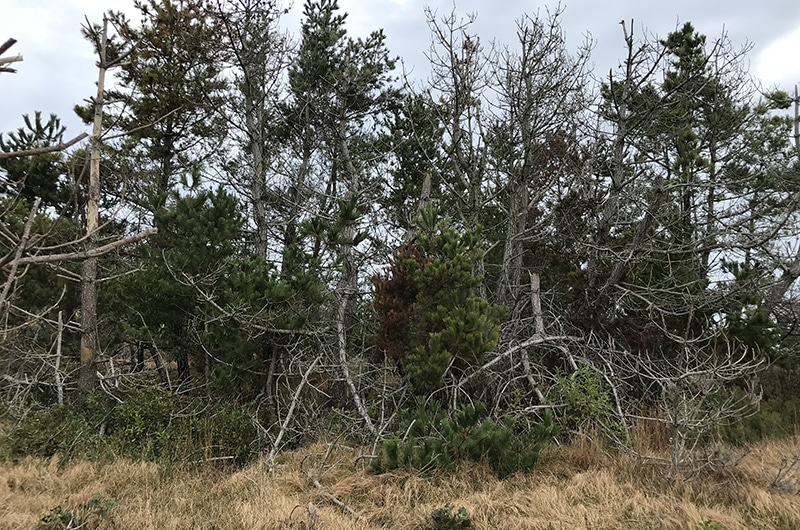Dr. Sarah Treanor Bois
Director of Research & Education at the Linda Loring Nature Foundation
As people return to the island it is often noted which restaurants have closed and reopened as something else, which streets now have stop signs, and what houses have newly popped up. The same is true for various conservation properties that may have undergone management over the winter. Case in point, heading out to the Linda Loring Nature Foundation on Eel Point Road, there have been some big clear cuts removing several pine stands.
In December of 2018, the Linda Loring Nature Foundation was awarded a $48,200 grant from the MassWildlife Habitat Management Grant Program to create and improve grassland habitats by removing non-native invasive tree species. It was the largest grant given this grant cycle.
The grant was used to fund the removal of standing dead and live invasive, non-native Japanese black pine (Pinus thunbergii) in an effort to restore sandplain grassland habitat.
The existing vegetation on the Foundation’s Eel Point Road property consists of a mix of sandplain grasslands, sandplain heathlands, and coastal shrublands.
In recent decades, the landscape has been invaded by Japanese black pine, a non-native invasive tree native to Japan and China. This fast-growing tree was originally planted in the early 1900s to provide a windbreak. However, Japanese black pine is susceptible to a turpentine beetle (Dendroctonus terebrans) feeding on the inner bark of the lower four feet of the trunk, and the tree can wind up as standing dead after reaching maturity. What were just a few trees decades ago are now large stands encroaching on sandplain grassland habitat which is host to rare and threatened plants and animals. Managing the trees is a high priority for the Foundation, as these pines are fire hazards, human health hazards as dead snags, and a threat to native biodiversity.

According to Executive Director Kitty Pochman, the project marks a turning point in land management the Loring Foundation.
By removing the invasive Japanese black pines, the landscape will be opened up to the grasslands and native heathlands beneath. The removal of the trees reintroduces the landscape to the wind and salt spray, which helped shape the landscape originally.
“Stewardship of our 108 acres of preserved land is a high priority for the LLNF. We are thrilled to be awarded this important grant from the commonwealth that will further our research and conservation goals,” Pochman said.
The direct treatment area is about six acres of nearly solid pine, both alive and standing dead. However, the effective area—the area that will benefit from treatment—is estimated to be over 50 acres as natural ecosystem processes are reinstated.
Within the treatment areas, there are also over 140 recorded individuals of the state-listed species of special concern, sandplain blue-eyed grass (Sisyrinchium fuscatum). This species requires open sandplain grassland and heathland habitat. The Japanese black pine trees are encroaching on these plants, crowding and shading them out.

With the help of skilled contractors, LLNF began management of the pines in January and February, when it is favorable to remove Japanese black pines. Under the terms of the grant, the work was completed by late April.
Winter is the best time to manage Japanese Black Pine. Similar pines, like the native pitch pine (Pinus rigida) have been used as roost trees for breeding Northern Long Eared Bats. These bats are state listed and federally endangered, so protecting their habitat is a priority. Because of this, there is a state-mandated moratorium on pine removal (of all species) during bat breeding season between June 1 and July 31.
Any pitch pines that were present within the management areas at LLNF were spared during the removal process.
Twelve towns and organizations across the state were awarded more than $300,000 in grants for wildlife habitat improvement projects. The Mass- Wildlife Habitat Management Grant Program was developed to establish partnerships between MassWildlife and private and municipal landowners to enhance habitat and increase recreational opportunities on properties across the state.
This year, funds provided through the grant program will benefit 12 wildlife habitat improvement projects, including LLNF as well as the Nantucket Conservation Foundation.
“Making smart investments in projects to restore and manage protected lands across the Commonwealth furthers our administration’s dedication to land conservation,” Gov. Charlie Baker said. “With this funding, municipalities and local organizations will be able to significantly improve habitat for rare and endangered species and enhance outdoor recreational opportunities.”
In early May, Senator Julian Cyr and State Representative Dylan Fernandez came to LLNF to tour the managed areas and learn more about island conservation and management.

“Stewardship of natural habitats is critical for communities on Cape Cod, Martha’s Vineyard and Nantucket,” Sen. Cyr said. “These monies will help ensure that native wildlife in our unique region of the Commonwealth is preserved for future generations.”
Following the cutting and removal of woody debris, the LLNF staff are monitoring the treatment areas for regrowth. Part of the restoration process is to see what plants come into the areas that are now clear of Japanese black pines.
At this point, there hasn’t been any addition of seeds. There are plenty of native grasses and forbs in the surrounding area that could naturally seed in and there is the potential for seeds that are still in the soil that have been long-dormant (in the seedbank).
So far, the most excited thing to come up has been a spectacular display of pink lady slipper orchids (Cypripedium acaule) at the western-most management site. While this area has had lady slippers in the past, the removal of the Japanese black pines spurred the emergence of many more blooms than usual.
In the coming years, the LLNF will continue to manage the Japanese black pine on the property; removing pine cones, clipping new sprouts, and cutting down larger stands.


